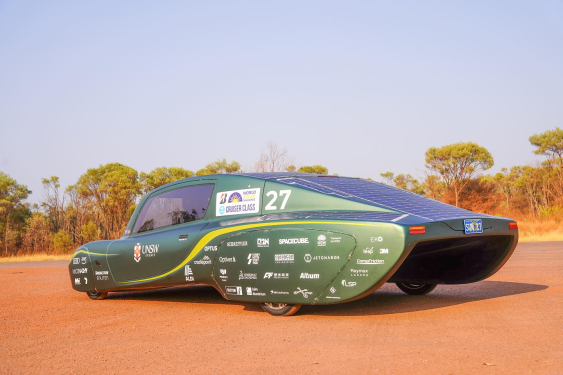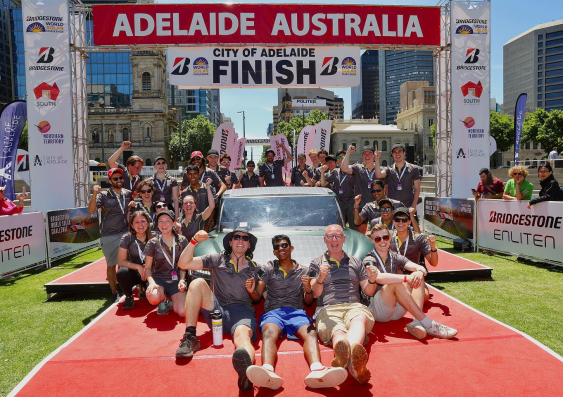UNSW Sydney’s student-built Sunswift 7 solar-powered car has been declared the winner of the (Cruiser Class) after strong winds wiped out the entire race.
The Sunswift car was dominantly leading the points classification on day four of the 3600km race from Darwin to Adelaide, before weather conditions threw the competition into disarray.
Competitors in the Cruiser Class were required to arrive at Coober Pedy from Alice Springs (a distance of around 650km) before 5pm ‚Äď but they were all severely hampered by the wind.
The conditions put such a toll on all the cars‚ÄôŐżbatteries that none of the five entrants still racing at that point were able to complete the stage in the allotted time, and they were all subsequently ruled out of the rest of theŐżChallenge.

Sunswift 7 was well ahead on points during the 2023 World Solar Challenge when strong winds disrupted the race and prevented all Cruiser Class competitors from reaching the check-point at Coober Pedy on time. Image from Sunswift Racing
Race organisersŐżannounced that the final results would be based on the standings from the previous checkpoint at Tennant Creek, where Sunswift was well ahead of its rivals.
In the Cruiser Class, positions are based not justŐżon which car drives the fastest, but instead on a points system that takes into consideration the energy usage of the car, the number of people inside the car and also therefore its ‚Äėpracticality‚Äô, as well as the time taken to complete each stage.
Until the unfortunate conclusion to the on-road race, Sunswift was significantly ahead on points throughout the competitionŐżthanks largely to its high rating for 'person kilometres travelled', boosted by carrying three passengers as well as its driver, as well as being ahead of the other Cruiser cars in each completed stage.
Despite that, the team still had to wait until a final scrutineering session on Saturday when a panel of judges gave an additional score to each car based on criteria such as design innovation, environmental impact, ease of access and egress, occupant space and comfort, ease of operation (driving and charging), versatility, and style and desirability.
Sunswift received high marks from the judges in that category as well, and wasŐżofficially announced as Cruiser Class champions at an awards event in Adelaide on Sunday evening.

Sunswift Racing team celebrate after arriving in Adelaide at the conclusion of the 2023 Bridgestone World Solar Challenge. Image from Sunswift Racing
Following all calculations, Sunswift finished top of the rankings with a total score of 91.1 points to claim the trophy, well ahead of the University of Minnesota in second place on 22.4, with Team Solaride from Estonia finishing third with 14.7.
It is the first time an Australian car has won the Cruiser Class category in the World Solar Challenge since it was first introduced back in 2015.
Sunswift 7 already after completing 1000km on a single charge in under 12 hours in December 2022.
team principal, Professor of Practice Richard Hopkins, said: “I could not be more proud of this team for what they have achieved.
“The work the students have done is simply amazing and I can only say positive things because they have been so focused and committed and professional.
‚ÄúThis is called a Challenge for a reason ‚Äď and it is obviously not an easy race. When you are competing against the best in the world you have to go right to the edge of what is possible. And when you are at the very margins then something uncontrollable like the wind can play a big part.
‚ÄúBut overall what we achieved is a massive success. We were the fastest car in the pre-race time-trial, we were ahead on the road, we were ahead on points and we travelled further than any other team.‚ÄĚ
Bridgestone World Solar Challenge race director Chris Selwood AM acknowledged the difficult conditions all the teams faced on the stage into Coober Pedy.
‚ÄúThe teams in this event are testing cutting edge technology, often not in-market and driving beyond the range of current electric vehicles,‚ÄĚ he said.
“To win the Cruiser Class takes a combination of strategic energy management, endurance and more than a little style. These solar electric cars, designed to bring the green to the mainstream, have never been about being first across the line.
"The CSIRO Cruiser Class goal is to bring solar electric cars to the everyday driver. Sunswift is not just a beautiful car, she’s cleverly designed to deliver maximum performance for the BWSC regulations."
Sunswift 8: say hi to hydrogen
With the 2023 World Solar Challenge now complete, the team of student engineers that makes up the Sunswift project will now focus on developing and building a brand-new car in 2024 that might not even be allowed to race in the WSC due to current regulations.
That’s because Sunswift 8 is likely to feature hydrogen fuel cells, in addition to solar panels.
Current designs indicate it will be a two-seater sports car that is capable of completing laps of Mount Panorama, where the famous Bathurst 1000 race takes place, only 20-30 seconds slower per lap than the fastest V8 Supercars.
It also promises to be more environmentally-friendly with the chassis potentially made of hemp and flax rather than carbon fibre.
‚ÄúSunswift 8 won‚Äôt just be a hybrid, it will be a tri-brid, utilising solar, batteries and hydrogen fuel cells in combination,‚ÄĚ Prof. Hopkins said.
“It means the car could potentially run on all three of those technologies, or just one at a time. Potentially there will be a little dial on the steering wheel to select which is being used.
‚ÄúIf you are just going round the corner to the shops you maybe just select solar. If the car is being used to drive to Canberra then perhaps you use battery and hydrogen. And if you are doing a lap of Bathurst then you might choose all three to give it the full beans.‚ÄĚ
Őż




